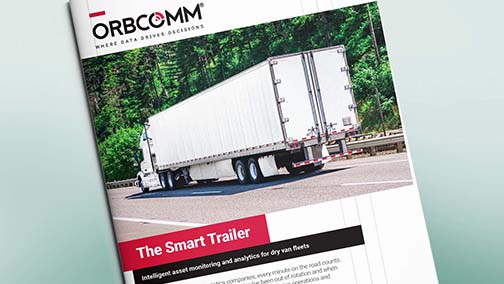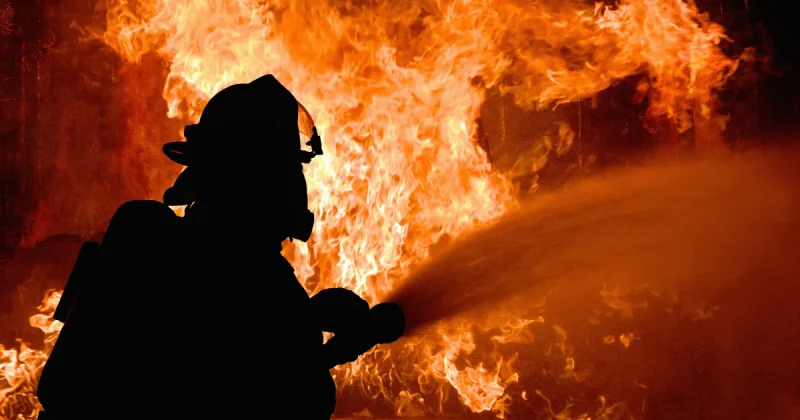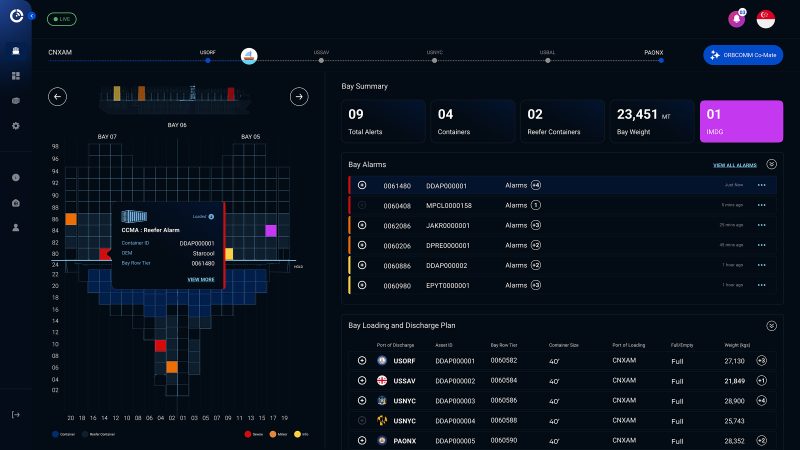
Everything you need to know about pre-trip inspection checklists
- Blog
- Transportation
- Everything you need to know about pre-trip inspection checklists
- Jan 18, 2024
- Cody Lirette

Embarking on a safe and efficient journey as a truck driver begins long before hitting the road. The cornerstone of every successful trip is a thorough pre-trip inspection. This guide delves into the essential aspects of a pre-trip inspection checklist. These critical checkpoints can make all the difference in your driver’s safety and the efficiency and success of the journey.
What is a pre-trip inspection?
A pre-trip inspection is a proactive measure taken by truck drivers to ensure their vehicles are in optimal condition and adhere to safety standards and other relevant regulatory requirements. This assessment checks for signs of wear, damage or malfunction on critical components like the engine, brakes, lights, tires, fluid and more.
The goal of a pre-trip inspection is two-fold: safety and compliance. A thorough vehicle examination helps identify potential issues so they can be addressed promptly, minimizing the risk of breakdowns and accidents. The inspection is crucial for compliance with industry regulations and standards. Failure to do so could result in fines, penalties or suspensions.
The importance of a pre-trip inspection
Pre-trip inspections are more than a regulatory requirement; they can help keep drivers and the public safe, maintain cargo integrity and improve vehicle longevity. Here’s why this practice is essential:
- Enhanced safety: Identifies potential mechanical issues before they escalate. This means reduced risk of breakdowns and roadside emergencies.
- Improved efficiency: Addresses issues before they happen on the road to ensure fleets deliver on time.
- Better compliance: Helps meet legal requirements, avoid unnecessary fines and penalties and comply with industry standards and safety protocols.
- Protected cargo: Ensures cargo is secure and adequately loaded, preventing damage during transit.
- Maintain equipment health: Identifies wear and tear on components, allowing for timely maintenance, reducing long-term repair costs and prolonging the longevity of the vehicle and its critical systems.
- Boosted reputation: Demonstrates a commitment to professionalism and responsibility. This enhances a fleet’s reputation and builds stronger customer relationships.
- Driver confidence: Following a standardized pre-trip inspection checklist reassures drivers that their truck is in optimal condition.
Main components of a pre-trip inspection checklist
To ensure drivers cover all the essential components of pre-trip inspections, here are the main checkpoints to keep in mind:
Tire inspection

- Tread depth: Measure tire tread depth. Inadequate tread depth can compromise traction and vehicle stability, especially in unfavorable road conditions.
- Tire inflation: Verify that all tires meet the manufacturer’s specifications. Improper inflation poses safety issues and can lead to uneven wear and reduced fuel efficiency.
- Visible tire damage: Inspect each tire for cuts, bulges or other visible damage. Address these issues promptly to prevent blowouts and other safety concerns.
- Valve stem integrity: Inspect valve stems for damage or leaks and ensure caps are in place. Damaged stems can lead to pressure loss.
Lights and reflectors
- Headlights: Ensure both high and low beams work. Check for proper alignment to maximize visibility without blinding other drivers.
- Taillights: Verify that taillights work, including brake lights and turn signals.
- Clearance lights: Ensure clearance lights work. These enhance the visibility of the vehicle’s dimensions, especially in low-light conditions.
- Reflectors: Confirm the presence and condition of reflectors on all sides of the vehicle.
- Hazard lights: Ensure hazard lights work.
- Turn signals: Ensure the turn signals work on both sides.
Brake check
- Air brakes: Check air brakes for leaks by listening for hissing sounds. Confirm that air pressure builds within a reasonable time after starting the engine.
- Parking brake: Test the parking brake to ensure it holds the vehicle securely.
- Brake fluid levels: Check the fluid reservoir for proper fluid levels. Low levels may indicate a leak or wear.
- Brake pads and shoes: Inspect brake pads and shoes for visible wear. They may need replacing if they are too thin or show uneven wear patterns.
- Brake drums and rotors: Examine brake drums and rotors for signs of scoring, grooves or heat-related damage.
- Brake lines and hoses: Pay attention to visible damage, corrosion, bulging or leaks.
- Anti-lock braking system: Check the dashboard for warning lights.
Engine compartment
- Engine oil: Check the engine oil level. Ensure it falls within the recommended range.
- Coolant: Ensure the coolant reservoir has the appropriate amount to prevent engine overheating.
- Drive belts: Examine for signs of wear, fraying or cracking.
- Hoses: Inspect hoses for leaks, bulges or soft spots. Replace any damaged hoses to prevent leaks.
- Battery: Check battery terminals for corrosion and ensure they’re securely connected. Loose or corroded connections can lead to electrical issues.
- Air compressor: Inspect the air compressor for visible damage and ensure proper functioning for optimal brake performance.
- Power steering fluid: Ensure power steering fluid levels are within the recommended range.
- Air filter: Check for decay and debris. A clogged air filter can reduce engine efficiency and fuel economy.
Fuel tank
- Fuel levels: Ensure the fuel tank is full.
- Fuel cap: Verify the fuel cap is tightly secured to prevent spillage and contamination.
- Fuel tank integrity: Inspect the tank for visible damage, rust or signs of leakage
Fluid inspection
- Transmission fluid: Check transmission fluid levels, ensuring they’re within the recommended range.
- Windshield washer fluid: Keep the washer fluid full.
- Differential fluid: Check differential fluid levels. Low levels can lead to differential damage and affect vehicle performance.
Windshield inspection
- Cracks and chips: Inspect the windshield for any cracks or chips. Address any large ones that affect visibility.
- Windshield wipers: Ensure the windshield wipers are functioning. Replace worn or damaged blades.
- Windshield washer jets: Confirm the windshield washer jets spray fluid evenly. Malfunctioning jets can result in uneven cleaning.
Emergency kit
A well-equipped kit ensures drivers are ready to handle unexpected situations on the road, promoting safety and efficiency:
- First aid supplies: Essential medical supplies including bandages, antiseptic wipes, pain relievers and any necessary personal medications.
- Reflective triangles or flares: Confirm that you have reflective triangles or flares to enhance visibility in case of roadside breakdowns.
- Fire extinguisher: Ensure the fire extinguisher has a valid inspection tag and is not expired.
- Essential tools: Check for the basics like a wrench, pliers and screwdrivers.
- Flashlights and batteries: Test the functionality of flashlights and ensure spare batteries are available.
- Blankets or sleeping bags: Essential for unexpected delays or overnight stops.
- Communication devices: Test radios or cell phones.
Mirrors
- Side mirrors: Confirm side mirrors are correctly adjusted for the driver’s line of sight and are securely attached.
- Convex mirrors: Verify the alignment of convex mirrors to provide an optimal wide field of view. Ensure they are not loose.
- Motorized adjustment: If mirrors have motorized adjustment capability, ensure these work.
Front suspension
- Shock absorbers: Inspect for leaks, visible damage or signs of wear.
- Springs: Pay attention to signs of sagging, damage or cracks.
- Bushings and mounts: Ensure bushings and mounts are in good condition and don’t have any significant wear, deterioration or damage.
- Alignment: Test steering stability to identify any abnormal vibrations or wandering.
- Tie rods and ends: Examine tie rods for signs of looseness, wear or damage.
Driver door
- Door Latches: Verify that door latches engage and disengage smoothly to maintain safety while driving.
- Hinges: Inspect door hinges for signs of wear, rust or damage.
- Seals and weatherstripping: Pay attention to any gaps, tears or deterioration of seals and weatherstripping. Proper seals prevent leakage and maintain a comfortable cabin environment.
Truck rear
- Mud flaps: Should be securely mounted.
- License plate: Ensure the license plate is securely attached and visible. A properly displayed license is crucial for regulatory compliance.
- Exhaust: Note any damage to the exhaust system, like rust or loose components.
- Rear doors or gates: If applicable, test the operation of rear doors or gates.
Coupling system
- Fifth wheel: Inspect for damage or misalignment.
- Kingpin: Ensure there is no wear or damage. A well-maintained kingpin ensures a secure attachment to the fifth wheel.
- Locking mechanism and safety latch: Test the locking mechanism to ensure it engages securely to help prevent accidental uncoupling during transit.
- Release handle: A properly functioning handle facilitates efficient coupling and decoupling.
- Connection hardware: Confirm that all connection hardware, such as bolts and brackets, is secure. Loose components can compromise the coupling system.
- Air and electrical lines: Inspect these lines for damage or leaks and ensure the trailer brake and light systems work.
Trailer
- Structural integrity: Inspect the trailer for signs of structural damage, including rust, dents or wear.
- Lights and reflectors: Check that all lights and reflectors are functional.
- Brake system: Test the trailer brake system, including service and emergency brakes.
- Suspension components: Inspect suspension components for signs of wear.
- Tires and wheels: Ensure proper tire tread depth and pressure.
- Cargo: Confirm that cargo is securely fastened and within legal limits.
- Landing Gear: Check for proper functioning to ensure stability during loading and unloading.
In-cab inspection
- Steering wheel: Ensure the steering wheel is aligned and stable.
- Seat and seatbelt: Adjust the seat for comfort and confirm the seatbelt is in good condition.
- Pedals: Test the functionality of gas, brake and clutch pedals.
- Instrument panel: Inspect gauges on the instrument panel for proper readings about the truck’s status.
- Documentation: Ensure necessary documents like permits are present and up to date. This is essential for regulatory compliance.
- Electronic devices: Test GPS and communication systems.
How to properly report a pre-trip inspection
Reporting a pre-trip inspection is not just an industry requirement. It’s also a critical communication tool between drivers and fleet management. To effectively report results, it’s important to:
- Use a standardized form provided by the company or regulatory body.
- Record observations in an organized manner.
- Be specific and descriptive.
- Prioritize safety concerns in the report.
- Include suggestions for corrective actions.
- Submit the report promptly to allow swift resolution of issues and minimize the risk of operational delays.
- If available, leverage digital reporting platforms for efficiency. Digital reports can transmit information in real-time, streamlining communication between drivers and management.
- Confirm that the report has been received and acknowledged by the appropriate personnel.
What to do if there are issues in the pre-trip inspection
Encountering issues during a pre-trip inspection is common, and educating drivers on the importance of reporting is crucial for ensuring road readiness and compliance.
If issues arise, ensure they are documented thoroughly and reported promptly. If problems are safety-related, communicate these concerns to management immediately. Always practice clear communication, like concise and descriptive language, to ensure a shared understanding and quick resolution.
Frequently Asked Questions
When should a driver perform a pre-trip inspection?
A driver should perform a pre-trip inspection before embarking on each journey. This proactive examination of the vehicle’s mechanical and safety components ensures it’s in optimal condition for the road. Conducting an inspection daily or before the start of each trip is a regulatory requirement in many jurisdictions. Plus, it can enhance driver safety, limit the risk of mechanical failures and contribute to overall road safety.
What is the first step of the pre-trip inspection?
The first step of a pre-trip inspection should involve an external assessment of the truck or commercial vehicle. This includes visually inspecting the vehicle’s overall condition, ensuring no visible defects or safety hazards. Start with a walkaround to identify any significant issues. Then, break the inspection down into components. For example, start with the tires, then move on to the lights, brakes, mirrors, and under the hood.
What is the most overlooked part of pre-trip inspection reports?
Drivers may focus on more visible components, like tires and lights, neglecting critical elements like brake lines, suspension and the exhaust system. Checking for signs of leaks, loose parts, or damage underneath the vehicle is crucial for identifying hidden issues that could compromise safety and performance. Completing every part of the checklist ensures a comprehensive assessment, reducing the risk of overlooking these critical components.
What happens if I don’t perform the inspection?
Failing to perform a pre-trip inspection can have serious consequences, both legally and in terms of safety. Regulatory bodies often mandate these inspections, and non-compliance can lead to fines, penalties or even the suspension of driving privileges.
Beyond legal implications, neglecting the inspection jeopardizes safety. Without identifying potential issues before hitting the road, there’s an increased risk of mechanical failures, accidents, and breakdowns, posing a danger to the driver and others on the road.
Additionally, failure to perform pre-trip inspections may impact insurance claims and the overall reputation of the driver and transportation company.
What is a DOT pre-inspection checklist?
A DOT pre-inspection checklist is a comprehensive list of items and components that commercial vehicle drivers must inspect before embarking on their trip, as mandated by the United States Department of Transportation (DOT).
Where should the ignition key be during the pre-trip inspection?
During a pre-trip Inspection, the ignition key should be in the “off” position. This is a standard safety practice to prevent accidents during the inspection. Keeping the ignition key off allows the driver to thoroughly examine various components without the risk of moving parts or unexpected vehicle movement. This includes checking the vehicle’s lights, brakes, tires and other essential elements. It’s a precautionary measure that promotes the safety of the driver and those in the vicinity during the inspection process.
How long should a pre-trip inspection reports take?
The duration of a pre-trip Inspection can vary depending on factors such as the driver’s familiarity with the vehicle, the complexity of the truck itself, and the thoroughness of the inspection. On average, a comprehensive pre-trip inspection typically takes around 15 to 45 minutes.

Cody Lirette is Senior Content Marketing Manager at ORBCOMM. With over a decade of marketing and communications experience for both the public and private sector, he uses his passion for innovative technology and plain language to build compelling content that inspires action.

















